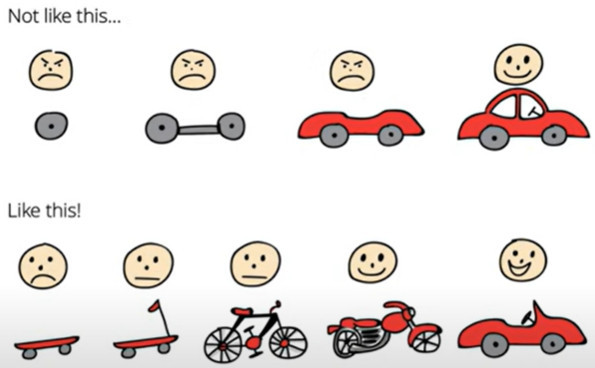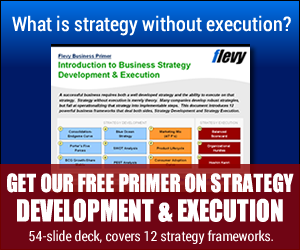This post explores the topic of Minimum Viable Product as a technique to learn rapidly and inexpensively about what customers want in the face of uncertainty. It looks at examples of Minimum Viable Products and their impact on strategy and project management.
What Is a Minimum Viable Product?
 The illustration at right, by Henrik Kniberg, provides some immediate context about what is meant by Minimum Viable Product (MVP):
The illustration at right, by Henrik Kniberg, provides some immediate context about what is meant by Minimum Viable Product (MVP):
MVP is not about building a product piece by piece, as there is no complete product until the end.
MVP is about building a product increment by increment for customers in feedback cycles.
To explore further, consider each of the three words that make up the phrase:
- Minimum – What is the least amount that you can deliver? Cost is a clear factor as spending the least amount, with the objective of learning the most to inform future iterations.
- Viable – What you produce demonstrates some value. It may be not satisfy all needs and desires, but it is enough of a solution to actually show a customer – and hence is ‘viable’.
- Product – It is an increment of a product – not a piece of a product. As the illustration shows, it is not a wheel, but a mode of transportation.
MVP is more than just step-by-step development; it represents the deliverable from a full cycle of development, on the journey of iteratively building a product which increasingly satisfies a customer’s needs.
The key to approaching MVP is to think big but to deliver product in small viable increments. Ask the question, “What is the cheapest and fastest way to learn?”
Another key is to remember that you are ultimately not only building a product, but a business model. Gear increments eventually around building all aspects of the evolving business model.
Examples of Minimum Viable Products
Here are three very different examples of where you can apply the MVP concept:
1. Software application
Let’s suppose that you were taking charge of building a human resources application for testing job applicants for certain skills and aptitudes. The long term view is that the application could potentially do many things including:
- Provide a series of questions to the applicant.
- Allow HR folks and hiring managers to enter and modify questions.
- Identify applicants who had the most interesting sets of answers to the questions.
- Compare applicants.
- Identify anticipated job performance depending on the answers to the questions or overall test performance.
- Make the application and all its metrics, tests, and functionality available throughout the organization.
- More features and functionality…
The point is that the list can get quite long!
A good approach might be to start out and prioritize those features and craft an MVP for one. A good starting point might be an applicant answering a single question – an initial MVP. Get feedback, and then proceed with an improvement, and build the application incrementally.
2. Physical product
Let’s say that you are in charge of building a new baby carriage product. How do you approach this?
It could be very similar to the graphic for a car at the top of the post.
Here are some features to consider:
- A plain rolling skateboard with the baby strapped in.
- Add a pull cord to pull it around.
- Add a push bar to push it.
- Add a canopy for privacy and shade.
- Add a light mattress and pillows for comfort.
- Add a mesh screen to keep insects out.
- Add a pocket to put a recorder to play music.
- Other features and functionality…
Now this is a list of features, and only the first is really even close to an MVP. But these features can be added to an MVP to improve it incrementally.
The best way to get started is to start with #1 and build the product – an MVP – and obtain feedback from a customer. Identify what they liked, and what they did not.
In the end, you may pivot – and this product could become a full toy, a self-propelled baby’s toy for toddlers, a bed…or any of a list of possibilities.
Your job is to learn and find what the customer wants, and build something that will increasingly satisfy.
3. Process
Another place to use the MVP concept is in business processes. Let’s say that in a small business, you have an accounts payables management process. From the beginning, you could break it down into the most manageable, simplest steps, then expand from there.
For example, start out with receiving the invoice then paying the bill. That is likely insufficient, so add a step for obtaining approval. Take it further by determining the due date, and if approved, pay on that date.
Continue to improve and increment the process until all stakeholders are satisfied. But the key is to start out with the minimum functionality – an MVP – and add capabilities from there.
If you want to further explore the broad examples of MVP, I recommend the “Minimum Viable Product Examples – How To Launch Like a Pro” video by Dan Holloway.
Minimum Viable Product and Strategy

Eric Ries, in his book “The Lean Startup”, discusses MVP and strategy at length. He brands a sort of lean agile management which combines several methodologies around the core MVP approach. In addition to the book, Eric maintains an official website about his continuing work in this area, including a blog, videos, slides, and audios.
Building capabilities inside the organization to build MVP’s and incrementally improve is a strategic capability. It acknowledges that not enough information is known up front to simply plan long term and execute – a waterfall-like approach. Instead, int provides the cornerstone to a lean agile approach that can move the company toward finding the products, markets, and customers that it needs to thrive and survive.
—————————————-
I recommend these strategy resources (paid link):
—————————————-
A Minimum Viable Product Template for Agile Projects
How do you plan an MVP?
Atlassian, a leader in project management software supporting agile development, has what they call an “MVP ideation template“. It contains a blend of strategy and project management.
—————————————-
I recommend these PM templates (paid link):
—————————————-
The approach starts the process of MVP ideation with 5 efforts:
- Problem to solve – Specifically and simply, define the problem you are trying to solve. What do you think is needed and why?
- Target Market – Who are the specific users of the product? Answer this specifically for the MVP that you are producing, but also consider your long term, ultimate target customers.
- MVP solution – What is the solution? What does it look like? What are its constituent parts? How are they assembled into a viable whole?
- Value proposition – Craft an initial Unique Selling Proposition. It needs to be something ha you could present simply and understandably to a customer. The uniqueness separates your solution from that of competitor or alternate solutions.
- Competitors – To support the value proposition, who are your competitors, and why is your solution better than theirs?
Building the capability to develop MVP’s is all about creating and refining processes that support the MVP effort. The above ‘template’ is a good starting point.
Conclusion and Further Resources
This post talked about how to develop a lean agile approach by building Minimum Viable Products (MVP). The key is to focus on learning about the underlying need.
Please share any experiences you have producing MVP’s?
Here’s a great video to demystify MVP – entitled “Making Sense of MVP” by Henrik Kniberg:

